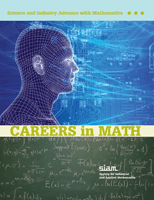Careers in Applied Math: New Brochure Available from SIAM
January 10, 2009

One of SIAM's strengths is the diversity of the membership, with a mix that includes not only applied mathematicians and---increasingly---computational scientists in many domain areas, but also substantial numbers of computer scientists, engineers of many kinds, and scientists whose work has significant quantitative components. Productive exchanges of ideas and discovery of common interests among people with ostensibly far-apart interests are among the positive aspects of the diversity. From the perspective of a math major hoping to go on to graduate school, though, the widely ranging options can appear as a bewilderingly complex landscape.
With such young people in mind, SIAM has produced a new booklet on careers in applied mathematics. The booklet identifies job titles that might not sound, but are, mathematical; companies, labs, and organizations at which such positions are found; resources for more specialized information; and---perhaps most usefully---snapshots of people working in the varied settings in which applied and computational mathematics is done.
The people profiled describe their paths to their current positions, along with their work activities. They offer advice to people who think the positions sound appealing, comment in some cases on where they see their research fields heading, and even provide (very wide) salary ranges.
Kimberly Drake, a mathematician at the Naval Surface Warfare Center, Machinery Research and Silencing Division, has a PhD in applied math with a concentration in computational science, from North Carolina State University. "I develop algorithms and technologies to solve problems related to diagnostics and prognostics" on Navy machinery, she says. "Once we develop or find an interesting algorithm for solving problems we have to actually implement and test the algorithm. This usually involves running experiments and analyzing the results. . . . Finally I'm building a video and image processing laboratory, which will have the 12 different varieties of video cameras used by the Navy."
Edmond Chow, a computational scientist at D.E. Shaw Research, has a PhD in computer science from the University of Minnesota. He describes a focused high school experience that included meetings "with Professor Tom Hull at the University of Toronto, with whom I did a small project on computing elementary functions. Later, I participated in Lawrence Livermore National Laboratory's high school program and got a chance to try programming on Cray supercomputers. By then, I was hooked."
Also interested in science, Chow "decided very early on that I wanted to apply numerical methods to science by doing computer simulations." Things came together for him in his senior year, "when I took three courses in numerical analysis and did a project in the computer science and applied math department."
At D.E. Shaw, Chow works on "the algorithms and software used in molecular dynamics simulations," playing what he calls "a highly varied and interdisciplinary role. Almost daily, I talk to chemists about their scientific problems, as well as hardware engineers who want to find accurate and efficient ways to implement chemistry algorithms."
With a PhD in applied mathematics from New York University, Karim Azar is a senior research associate at Merck Research Laboratories. "I interface with people with a very diverse set of educational backgrounds, including imaging scientists, biologists, physiologists, physicians, and others. My primary function is to work closely with these scientists to provide mathematical solutions that address the medical and business needs as defined by decision makers within Merck. Once the problem is identified, I work with my team on formulating a mathematical model and delivering the solution within agreed upon timelines and expectations."
Peter Norvig, director of research at Google, majored in applied math as an undergraduate (Brown University) and has a PhD in computer science from UC Berkeley. "Get involved in projects beyond your coursework," he suggests. Whether in a research project with a professor, a contribution to an open-source project, work at a company outside of school, or a competition, "you learn a lot by doing a project: how to work with others, how to meet deadlines, to compare yourself to others, and the thrill of accomplishing something worthwhile." His second piece of advice (which ties in with the first) is to "surround yourself with the best peers you can find, and learn from them."
Faculty in applied math and computational science are encouraged to direct their students to this new resource. The booklet can be downloaded on the Web at www.siam.org/careers/thinking.php. Visitors to the Web site can also request one free print copy of the brochure via e-mail; additional copies are available for a small fee. Customized copies of the brochure can be created for companies interested in disseminating print copies to audiences of their choosing.
Additional information is available from Jessica Stephenson ([email protected]).

